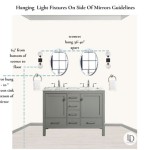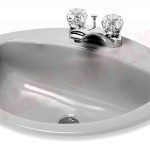Bathroom Sink Has Bad Odor: Identifying Causes and Remedial Measures
A persistent, unpleasant odor emanating from a bathroom sink is a common household problem that can significantly detract from the overall cleanliness and hygiene of the space. The source of these odors is often multifaceted, stemming from a combination of organic buildup, plumbing issues, and environmental factors. Identifying the precise cause is the first step towards implementing effective remedial measures and restoring a fresh and sanitary bathroom environment.
Ignoring a foul-smelling bathroom sink is not advisable. The odor itself is an indication of underlying issues that, if left unaddressed, can escalate and potentially lead to more serious problems, such as clogged drains, bacterial growth, and even plumbing damage. Furthermore, the presence of unpleasant odors can negatively impact air quality and create an uncomfortable living environment. A proactive approach to diagnosing and resolving the source of the odor is essential for maintaining a healthy and hygienic bathroom.
The complexity of a bathroom sink’s plumbing system, coupled with the daily accumulation of various substances, contributes to the potential for odor development. Soap scum, hair, toothpaste residue, and other organic matter can accumulate within the drainpipe and P-trap, creating a breeding ground for bacteria and fungi. These microorganisms break down the organic matter, releasing foul-smelling gases such as hydrogen sulfide, which is often responsible for the characteristic "rotten egg" odor associated with plumbing problems.
Accumulation of Organic Material and Biofilm
One of the primary causes of bad odors emanating from a bathroom sink is the accumulation of organic material and the subsequent formation of biofilm within the drainpipe. Biofilm is a complex community of microorganisms that adhere to surfaces and form a slimy, often odorous, layer. In the context of bathroom sinks, this biofilm typically consists of bacteria, fungi, and other microorganisms that feed on soap scum, hair, and other organic debris that wash down the drain. The metabolic processes of these microorganisms result in the production of various gases, including hydrogen sulfide, ammonia, and methane, all of which contribute to the unpleasant odor.
The warm, moist environment within the drainpipe provides an ideal breeding ground for these microorganisms. The constant flow of water and organic matter provides a continuous supply of nutrients, allowing the biofilm to thrive and expand. Over time, the biofilm can become quite thick and resilient, making it difficult to remove with simple flushing or cleaning methods. Regular cleaning and disinfection are necessary to prevent the buildup of biofilm and the associated odors.
The composition of the organic material that contributes to biofilm formation can vary depending on the habits of the household members and the types of products used in the bathroom. For example, individuals who use greasy hair products or frequently shave at the sink may contribute to a greater accumulation of oily residues within the drainpipe, which can exacerbate the problem. Similarly, certain types of soaps and detergents may contain ingredients that are more prone to forming soap scum and contributing to biofilm formation.
To mitigate the accumulation of organic material and biofilm, it is recommended to regularly flush the sink drain with hot water and to use a strainer or mesh screen to trap hair and other debris before they enter the drainpipe. Additionally, periodic cleaning with a disinfectant solution can help to kill the microorganisms within the biofilm and prevent the formation of foul-smelling gases.
Dry or Malfunctioning P-Trap
The P-trap, a U-shaped section of pipe located under the sink, plays a crucial role in preventing sewer gases from entering the bathroom. This trap is designed to hold a small amount of water, which acts as a barrier to block the passage of gases from the sewer line into the living space. If the P-trap dries out or is not functioning properly, sewer gases can escape into the bathroom, resulting in a strong and unpleasant odor.
A dry P-trap can occur for several reasons. In infrequently used bathrooms, the water in the trap may evaporate over time, particularly during periods of low humidity. Additionally, a leak in the P-trap can allow the water to slowly drain away. Furthermore, a plumbing issue such as a blocked vent pipe can create negative pressure within the drainpipe, siphoning the water out of the P-trap.
To determine if a dry P-trap is the source of the odor, simply run water in the sink for a few minutes. This will refill the trap and re-establish the water barrier. If the odor disappears after running water, a dry P-trap is likely the culprit. In such cases, it is important to identify the underlying cause of the dry P-trap, such as infrequent use, a leak, or a blocked vent pipe, and to take appropriate measures to address the issue.
If a leak is suspected, carefully inspect the P-trap for any signs of water damage or corrosion. Tighten any loose connections and replace any damaged components. If a blocked vent pipe is suspected, contact a qualified plumber to inspect and clear the vent. Regular use of the sink and periodic flushing with water can help to prevent the P-trap from drying out, particularly in infrequently used bathrooms.
Ventilation Problems and Sewer Gas Intrusion
Proper ventilation is essential for maintaining a healthy and odor-free bathroom. The plumbing system relies on a network of vent pipes that allow air to enter and exit the drainpipes, preventing the buildup of pressure and ensuring that wastewater flows freely. If the vent pipes are blocked or restricted, negative pressure can develop within the drainpipes, potentially siphoning water out of the P-traps and allowing sewer gases to enter the bathroom.
Sewer gas is a complex mixture of gases that are produced by the decomposition of organic matter in the sewer system. These gases can include hydrogen sulfide, methane, ammonia, and other volatile organic compounds. Hydrogen sulfide is particularly noticeable due to its characteristic "rotten egg" odor, even at low concentrations.
Blocked vent pipes can occur for a variety of reasons, including debris accumulation, bird nests, and ice formation. To check for ventilation problems, inspect the vent pipes on the roof of the house to ensure that they are clear of any obstructions. If the vent pipes are difficult to access or if you are uncomfortable working on the roof, it is best to contact a qualified plumber to inspect and clear the vents.
In addition to blocked vent pipes, other plumbing issues can contribute to sewer gas intrusion. Cracked or damaged drainpipes can allow sewer gases to escape into the bathroom. Also, improperly sealed plumbing fixtures can create pathways for sewer gases to enter the living space. If you suspect a plumbing leak or a damaged fixture, contact a qualified plumber to inspect and repair the problem.
Adequate bathroom ventilation is also important for preventing the buildup of moisture and humidity, which can contribute to mold and mildew growth. Mold and mildew can also produce unpleasant odors, which can exacerbate the problem. Ensure that the bathroom is properly ventilated by using an exhaust fan during and after showers and baths. Regularly clean and disinfect the bathroom to prevent the growth of mold and mildew.
Addressing the issue of a smelly bathroom sink requires a systematic approach to identify the root cause of the odor. Simple solutions, such as flushing with hot water and cleaning with baking soda and vinegar, can be effective for minor issues. However, more complex problems, such as blocked vent pipes or damaged plumbing fixtures, may require the assistance of a qualified plumber to diagnose and repair the issue effectively. Regular maintenance and preventive measures can help to keep the bathroom sink clean and odor-free, ensuring a healthy and pleasant living environment.

How To Clean A Stinky Sink Drain Home Repair Tutor

How Can I Help A Stinky Bathroom Sink Drain Cleaning More

Bathroom Sink Drain Smells Bad Get Rid Of Odor

How To Clean A Stinky Sink Drain By Home Repair Tutor

How Can I Help A Stinky Bathroom Sink Drain Cleaning More
What The Heck In This Ugly Black Stuff My Wife Has Been Complaining About A Nasty Smell Coming From Her Bathroom Sink Since We Moved Into Our New House Two Years Ago

Moldy Smelling Water From Bathroom Faucet Hometalk

Why Is There A Bad Smell Coming From My Bathroom Sink

7 Causes Of A Sewer Smell In The Bathroom Hays

How To Clean A Stinky Sink Drain Home Repair Tutor
Related Posts







